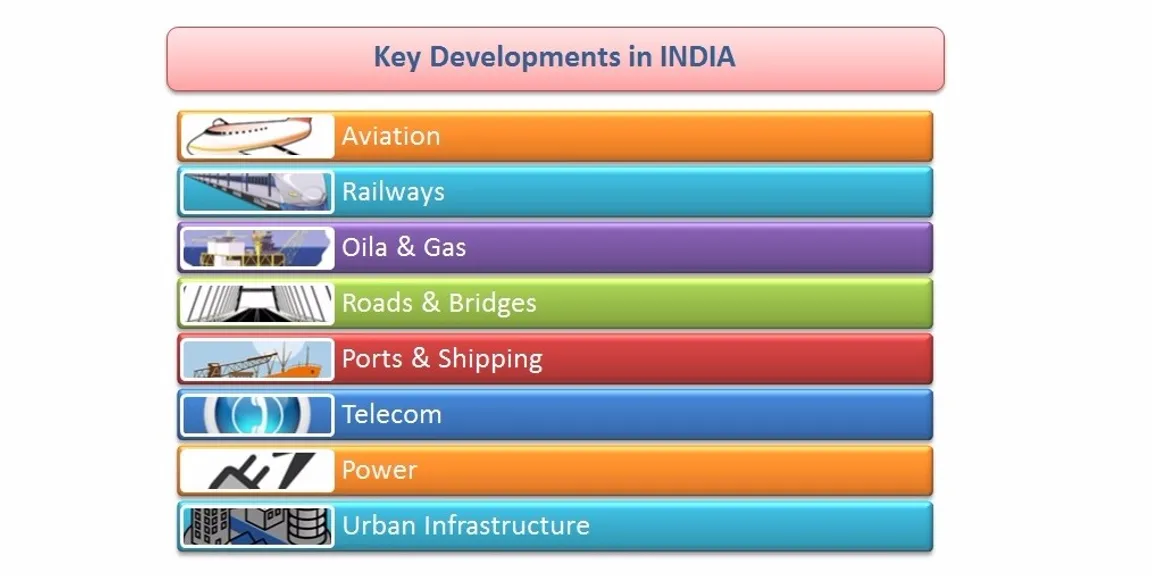

Key Developments in INDIA

In recent studies, I find 8 Key Development areas in India. These are:
1. Aviation
2. Railways
3. Oil & Gas
4. Roads & Bridges
5. Ports & Shipping
6. Telecom
7. Power
8. Urban Infrastructure
Out of these 8, I am sharing some Information on Aviation, Railways, Oil & Gas and Ports & Shipping.
Aviation:
India’s civil aviation industry is on a high-growth trajectory. India preparing this industry in such a way that it can become the third-largest aviation market by 2020 and the largest by 2030.
The Civil Aviation industry has stepped into a new era of expansion, driven by catalyst like low-cost carriers (LCCs), modern airports, FDI in domestic airlines, IT interventions and growing emphasis on regional connectivity. India is the ninth-largest civil aviation market in the world, with a market size of around US$ 16 billion.
During January-August 2016, domestic air passenger traffic rose 23.14 percent to 64.47 million from 52.36 million during the same period in 2015. Passenger traffic during FY 2015-16 increased at a rate of 21.3 percent to 85.57 million from 70.54 million in the FY 2014-15.
In July 2016, total aircraft movements at all Indian airports stood at 168,400, which was 14.3 percent higher than July 2015. International aircraft movements increased by 8.2 percent to 32,830 in July 2016 from 30,330 in July 2015. Domestic aircraft movements increased by 15.8 percent to 135,570 in July 2016 from 117,050 in July 2015.
Oil & Gas:
This sector is among the six core industries in India and playing a vital role in influencing decisions for all the other important parts of the economy.
In 1997–98, the New Exploration Licensing Policy (NELP) was envisaged to fill the ever-increasing gap between India’s gas demand and supply. India’s economic growth is closely related to energy demand; therefore the need for oil and gas is projected to grow more, thereby making the sector quite conducive for investment.
India is expected to be one of the largest contributors to non-OECD petroleum consumption growth globally. Domestic refiners’ import of crude oil increased 9.1 percent year-on-year to around 18.81 million metric tons during August 2016.1
In India, total fuel consumption is expected to increase around 5% to 6% in FY 2016-17, while consumption of gasoline is expected to grow around 9% to 10%.
India is the fourth-largest Liquefied Natural Gas (LNG) importer after Japan, South Korea, and China, and accounts for 5.8 percent of the total global trade.3Domestic LNG demand is expected to grow at a CAGR of 16.89 percent to 306.54 MMSCMD by 2021 from 64 MMSCMD in 2015.
Ports & Shipping:
Our Nation (India) has 12 major and 200 minor and intermediate ports. Cargo traffic is expected to reach 1,758 MMT by 2017. The Indian ports and shipping industry plays a significant role in stabilizing growth in the country’s trade and commerce. India is the sixteenth largest maritime country in the world, with a coastline of about 7,517 km.
Cargo traffic handled by India’s Major ports increased 4.6 percent year-on-year to 264.73 million tons (MT) during April-August 2016. In terms of the composition of cargo traffic, the largest commodity was P.O.L. (32.44 percent), followed by coal (24.09 percent), container traffic (19.65 percent), other cargo (12.68 percent), iron ore (4.6 percent) and other liquids (4.13 percent).
The country’s major ports handled a combined volume of 718,000 Twenty-foot-Equivalent Units (TEU) during August 2016, up from 679,000 TEUs during the same month last year, while containerized cargo tonnage rose 3.7 percent to 10.5 MT during August 2016. During April-June 2016, the ports had handled a combined volume of 2.12 million TEUs, which is roughly around 70 percent of the country’s overall container trade.
Railways:
The Indian Railways is among the world’s largest rail networks. Spread across 6,853 stations, the 108,706-km network enables the running of 11,000 trains on a daily basis. India's railway network is recognized as one of the largest railway systems in the world under single management.
In August 2016, fright earnings were declined 3.66% year-on-year to Rs 7,252.42 crore (US$ 1.08 billion), while freight loading stood at 85.36 Million tons (MT), while Passenger earnings in August 2016 rose 4.53% year-on-year to Rs 3,872.57 crore (US$ 577.45 million), while earnings from other coaching rose 3.10% to Rs 338.45 crore (US$ 50.47 million). The total approximate numbers of passengers booked during August 2016 rose 1.87% year-on-year to 701.28 million.




